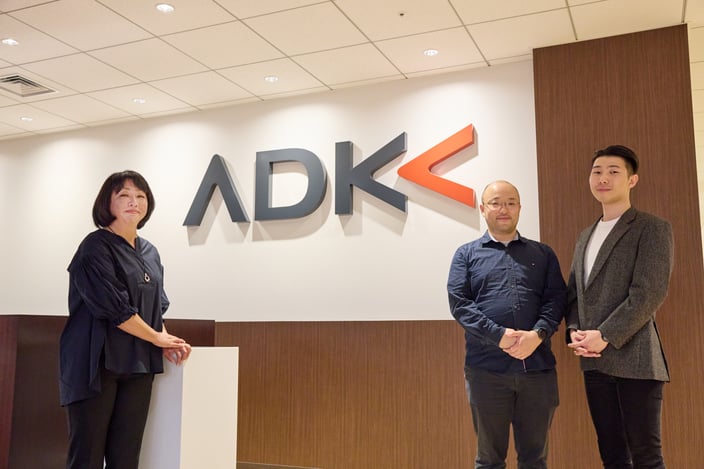Brand Assessment for building an SDGs-compliant “Sustainable” Company
In this article, we will show how you can install brand surveys effectively to sustainable management.
- 30 years to SDGs
- Towards a “carbon-free” society
- What is Sustainable Management and how companies should deal with it?
- How can branding be useful for enhancing corporate values and sustainable management?
- The Good Cycle
- Brand Survey designed for Sustainable Management
- Case studies
- Challenges to confront
30 years to SDGs
Let’s start by looking back at the trajectory of the past 30 years.
Since the late 90s, caring about the global environment and the act to the climate change impacted the way of business of corporations.
| 1997 | Climate Change | United Nations Framework Convention on Climate Change (Kyoto Protocol) adopted. Sets binding targets of each industrialized countries and economies of an average 5% emission reduction compared to 1990 levels over the five-year period 2008–2012. |
| 2006 | ESG | PRI launched at the New York Stock Exchange. Development and foundation led by then United Nations Secretary-General Kofi Annan, where it first publicly introduced the term ESG. |
| 2010 | CSR | ISO standard on CSR published (ISO 26000:2010). Encouraging organizations to respect the society and environment as doing the “right thing”. |
| 2015 | SDGs | 2030 Agenda for Sustainable Development, adopted by all United Nations member states. A 15-year plan with 17 goals. |
- In 1997, the Kyoto Protocol, setting each industrialized countries' emission reduction target, was adopted. Taking effect in 2005, although there were lack of full participation and many controversial criticisms over the effectiveness, we can say it dropped a huge attention and impact toward the global actions against the climate change.
- In 2006, the Principles for Responsible Investment (PRI) was launched at the New York Stock Exchange. It consists of 6 principles on embracing and integrating ESG (environmental, social and governance) considerations. Now there are total of 4,308 signatories (as of September 5th, 2021).
- In 2010, the ISO standard on corporate social responsibility (CSR) was published. Since then, it has been assisting the promotion of common understanding of social responsibility within the organization and encouraging them to contribute to sustainable development as their fundamental duty and essential role in the society.
- In 2015, the 2030 Agenda for Sustainable Development was adopted by all UN member states. A 15-year plan to take action to end poverty, protect the planet, and all people enjoy peace and prosperity by 2030. At the heart of the plan it has 17 Sustainable Development Goals (SDGs) -- 1: No Poverty / 2: Zero Hunger / 3: Good Health and Well-being / 4: Quality Education / 5: Gender Equality / 6: Clean Water and Sanitation / 7: Affordable and Clean Energy / 8: Decent Work and Economic Growth / 9: Industry, Innovation and Infrastructure / 10: Reduced Inequality / 11: Sustainable Cities and Communities / 12: Responsible Consumption and Production / 13: Climate Action / 14: Life Below Water / 15: Life on Land / 16: Peace and Justice Strong Institutions / 17: Partnerships to achieve the Goal.
Numerous discussions are held but “social responsibilities” or “community involvement” and “prioritizing” this issue is an inevitable major trend in corporate management. It is not good enough nowadays for companies to just say “raise profit and return that to investors”. Goals and purposes such as “enhancing the corporate value” or “leveraging the social value” are words that we see today. And “Purpose Branding” comes into play for achieving those goals.
Towards a “carbon-free” society
Today, we see “zero-emission” or “carbon-free”, “carbon-neutral” in the news and people talking everywhere, every day.
What do you think companies are expected for this issue?
Does any of the following ring your bell?
- Clear commitment
- Tree planting activities
- Product and service development
- Contributing to making a sustainable society
- Utilization of technologies
- Alliances with other companies
In the Nikkei SDGs Management Survey, conducted in April 2021, we asked over 600 businesspersons in the United States and the United Kingdom.
The top action a company is expected towards “carbon-free” was “Clear commitment”. It is thought to be much more important than technology or installing renewable energy.
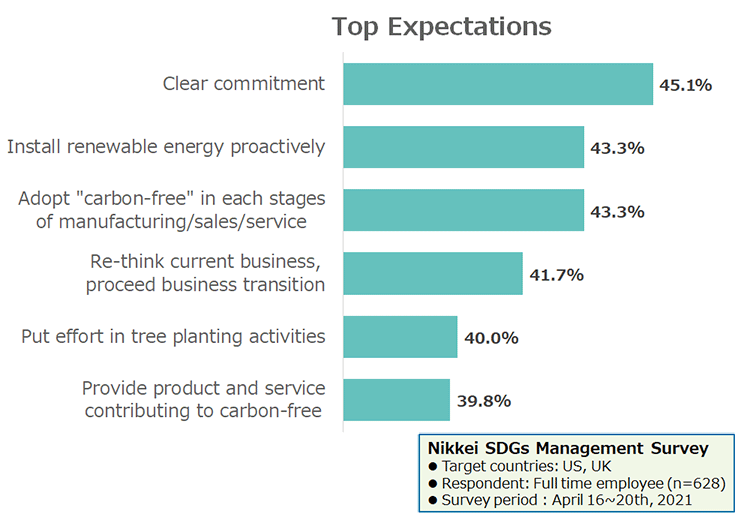
What is Sustainable Management and how companies should deal with it?
Ask yourself this question, “What does your corporate vision or mid-long term plan include over sustainability?“
These are voices we hear from a lot of our clients.
- Is watching stock price and revenue good enough to evaluate corporate value?
- When trying to enhance social value, how do we define that value?
- We’ve been reducing the environmental impact regarding the industry standards, but would that mean co-existing in the society with harmony?
- Easy to say, hard to do...(contribute in making a sustainable society / SDGs management)
- We’ve begun planning to create shared value, but…
They say that first of all, it is difficult to define the corporate value in a sustainable narrative.
Also, it seems to be hard to imagine what we should do other than environment-friendly measures, beyond regulatory requirements.
The ultimate outcome of a company would be some financial achievement such as revenue or stock price, but we see the emerge of non-financial aspects when measuring the corporate value today. We sense through various situations -- necessary for using the products/services, profitable as an investment target, Good to seek partnership, etc. In other words, the value can be said as how much that company is needed and important.
When trying to increase corporate value, what should we focus on? --As a short answer, it might be easier to think of it increasing the volume of support. The more people you can endorse, the more you have value. When you have high value, that would lead to a continuous business, making the company sustainable.
The surrounding environment of a business is rapidly changing, and the stakeholders of your company are diverse. In addition, stakeholders who have the power to influence other people and affect your company is expanding. So, dealing with the social expectations and setting forth sustainable management is an urgent top priority issue.
How can branding be useful for enhancing corporate values and sustainable management?
In this changing era, branding should evolve too. But what is branding for sustainable management?
A classic branding is product-centric and focuses on directing people to purchase. “New Branding” engages with diverse stakeholders and put effort to gain their favorability, interests, or sympathy through corporate activities.
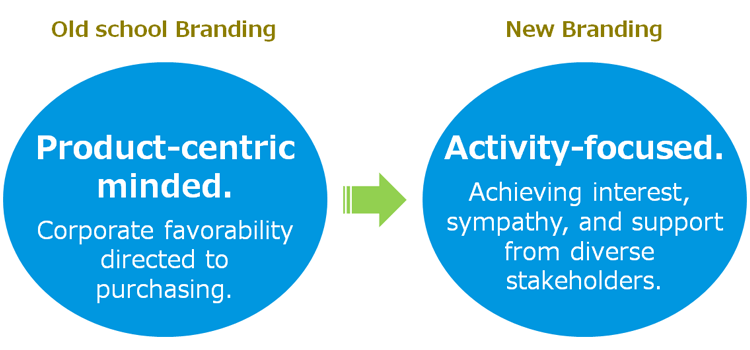
Stakeholders are miscellaneous. They are not only consumers but contractors, partners in the supply chain, investors, external rating companies, media, NPOs, making the new branding very complex.
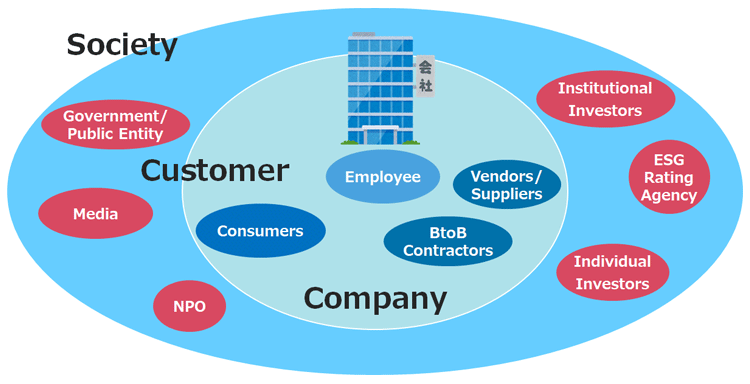
Alternative to “branding”, “communication” may be more suitable. Thinking of “who” and “what” you want to deliver messages, the communication strategy upon each target is necessary.
The biggest difference between classic branding and new branding would be the objective of the survey. The objectives changed due to the change of the surrounding business environment. When the objective change, you need to upgrade the scheme. Although some evaluation items used in periodical observation would stay, you should re-think the target and the KPIs.
The Good Cycle
When we think about the ideal state where the company is making progress in increasing its values, it has a good cycle underneath with two faces. Not just providing good products and services but inducing positive perceptions from corporate stance and activities evoking sympathy and stimulate purchase. Those effects would not be completely visible, although, the outcome would be resulted in sales or stock price, resulting in an increase in corporate value and sustainability.
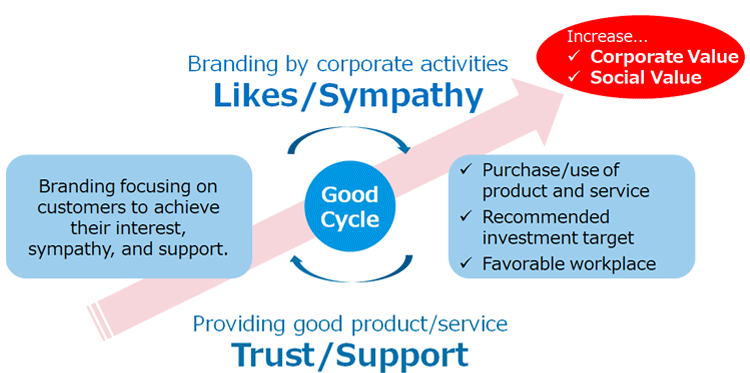
If there is a problem with the cycle, in most cases, a disconnection between the products/services and branding is occurred. The linkage is unknown, and it is hard to come up with effective measures. Those are where classic brand surveys cannot cover.
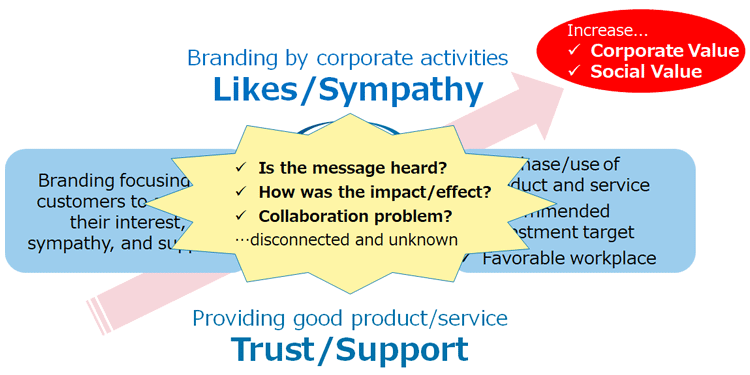
Brand Survey designed for Sustainable Management
As we’ve seen the stakeholders being broad and diverse today, it is hard to decide where to start with. We must stop and re-think the “Who”, “What”, and “How”.
| Who | Choose the target from the broad diversity of stakeholders. |
| What | What is to be recognized? Do we need new material? |
| How | Is the predecessor’s way still effective? |
If you lack information of your current status, even brainstorming could be difficult. In that case, surveys can be an excellent way for starters.
When planning and designing a survey, these are some of the concerns our clients have.
- How do the SDGs related activities increase brand equity?
- The stakeholders are diverse and don’t know where to start.
- Can’t link the results to actions.
- Have good reputations from customers but feel the gap between competitors.
Case studies
One of our clients had an objective to discover the relationship between brand equity and corporate activities for identifying what actions they should take for gaining good perceptions. Stagnant growth in brand equity, poor recognition of their SDGs related activities, were also the challenges they were facing.
By installing the Nikkei Research framework and evaluating the news article where the company appeared, they were successful to unveil the effect on the brand strength of their activities and were able to have effective strategic planning. Nikkei Research provided an efficient framework for setting KPIs, and expertise in this field.
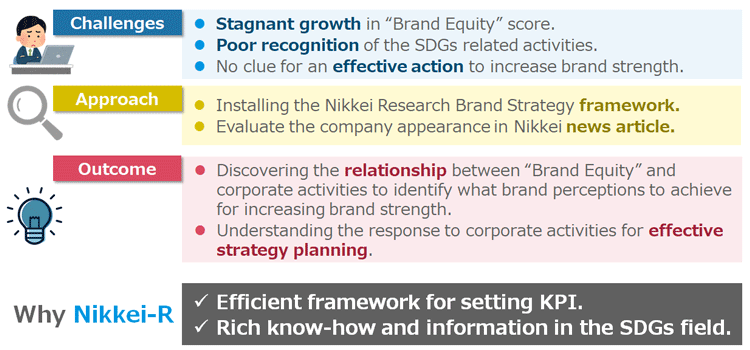
Another client had trouble in making actions from results. They had a wide gap from what they intended to be. First, they modified their target audience, and then re-designed the survey for adapting to the current situation. In the internal report, they included the next action from the insights derived by the survey. Nikkei Research gave advice from the re-design of the survey, with rich knowledge and information opposing to the challenges from the social changes coming.
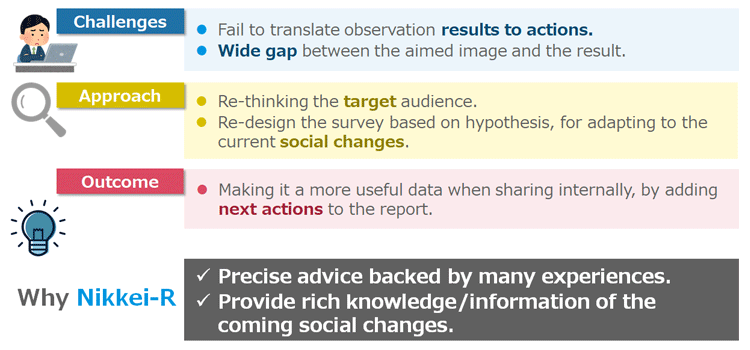
Challenges to confront
There are three major issues of failure. First, when there are conflicts between the activities and the products and services. Second, when there is a wide gap between the expectations from the stakeholders. When the message has no credibility with actual actions, or one is too far away from the ideal state, or missing the expectations. Last but not the least, when recognition and understanding is low.
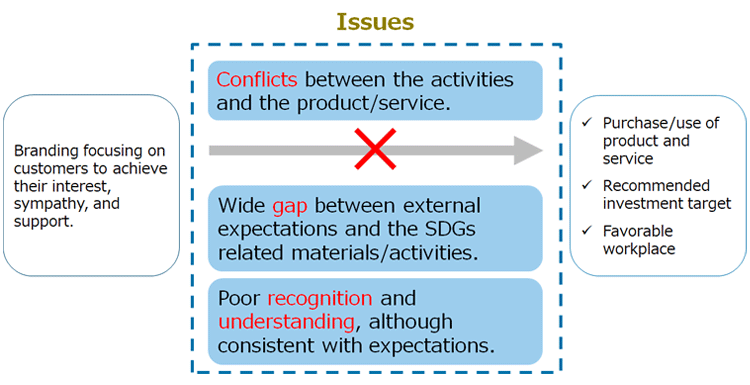
The causes of the issues underlying would be various. One is the lack of “story” or unclearness of the reason why the organization must do such activities. When that happens, cultivating a positive corporate image is ineffective. Particularly in the case of SDGs, the cause might be, when the actions are built bottom-up from what the company can do rather than what they are expected to do, or poor communication with stakeholders, or even not paying enough attention to third-party ratings.
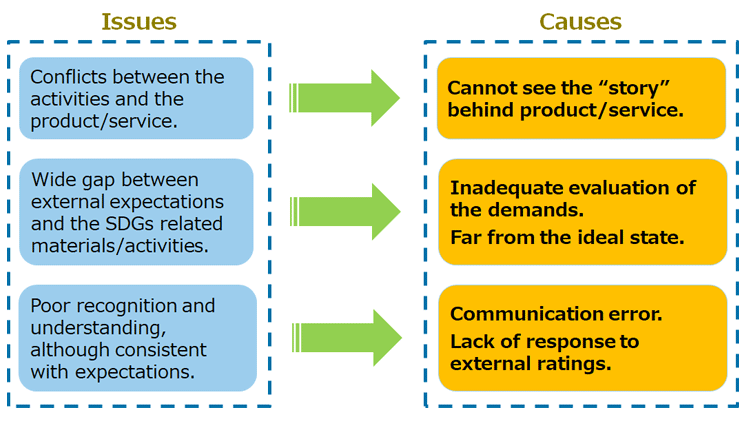
Our approach enables us to explore the causes behind those issues.
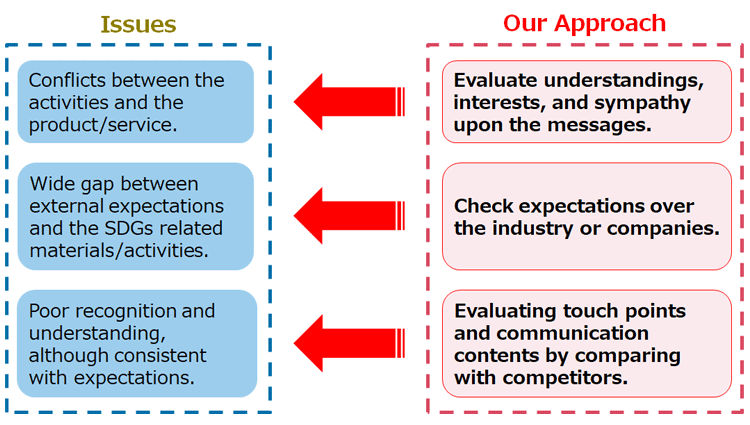
When there are conflicts, we should evaluate the content.
When there is a wide gap, we might need to list the expectations first.
When there is a communication failure, it might be good to see a best practice of a leading company.
Up-to-date branding know-how and the expertise/data on sustainable management is what we can provide and what you will need today.
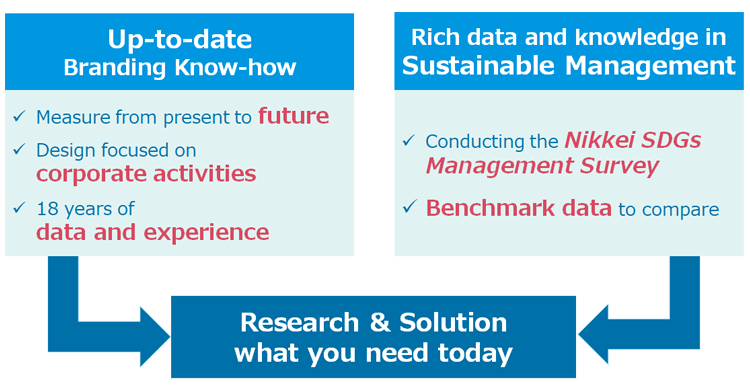
This content was brought to you by the SDGs Management Project Team of Nikkei Research.
If you would like to know more, please contact us.
please contact us below.

